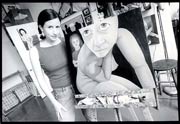Chris Shott, a writer for the Washington City Paper, caught wind of my story about my painting, "Exposed", that was pulled from a show at the GW University Breast Care Center in May 2004. He interviewed me and wrote the following article. Unfortunately, after a heated debate among City Paper editors, they decided not to run the story due to worries that it was "insensitive."
Should I thank Janet Jackson for all this nonsense?

Photo Credit: Charles Steck
"Breast Intentions"
by Chris Shott of the Washington City Paper
But in fact, such exposure is too taboo, even for the breast-care center.
On May 6, D.C. artist Dana Ellyn Kaufman learned that her oil painting titled Exposed got yanked from display at the center because the image included--gasp!--a nude boob.
"It's a very demure pose," says Kaufman. "It's a nude female figure who's covering herself, arms crossed, but one breast is slightly exposed."
"It's not like I painted a picture of someone ripping their shirt open with these big, voluptuous boobs."
Censorship is nothing new for Kaufman. Two years ago, she says, her painting, titled Pick 3, was removed from the National Press Club after members complained about the image, which depicted a young girl tugging on her wedgied underwear.
That's nothing compared to some of Kaufman's racier paintings: The nude woman in Who's It Gonna Be? is holding two knives--one pressed to her neck, the other against her pregnant belly. And Baby Back Ribs features a toddler sitting on a silver plate, his skin and muscle pulled back to reveal bone. "Someone asked to get off my mailing list because of that one," she says.
So Kaufman was "surprised," she says, when Exposed, one of her "prettier, less confrontational pieces," was deemed too offensive for the breast-care center. "I thought it would be a safe haven to have a picture with a breast showing," she says.
Of course, it wasn't. "I don't allow any pictures of breasts," says Jean Lynn, program director for the breast-care center, which also only accepts women's artwork. The exclusion of mammary imagery, she says, is out of sensitivity to breast-cancer patients facing mastectomy surgery.
"If women have lost or are losing their breasts," Lynn explains, "they don't need to see some voluptuous breast on the wall to remind them of their trauma."
"It's not that it's not good," Lynn says of Kaufman's work. "It's just that it's not appropriate here."
Kaufman, meanwhile, thinks all this breast talk misses the point. After all, her painting is "not about the boob," she says. Look instead, she suggests, into the woman's face. Viewers are "drawn to it," she says, "by the way the eyes look."
Copyright 2004 Dana Ellyn